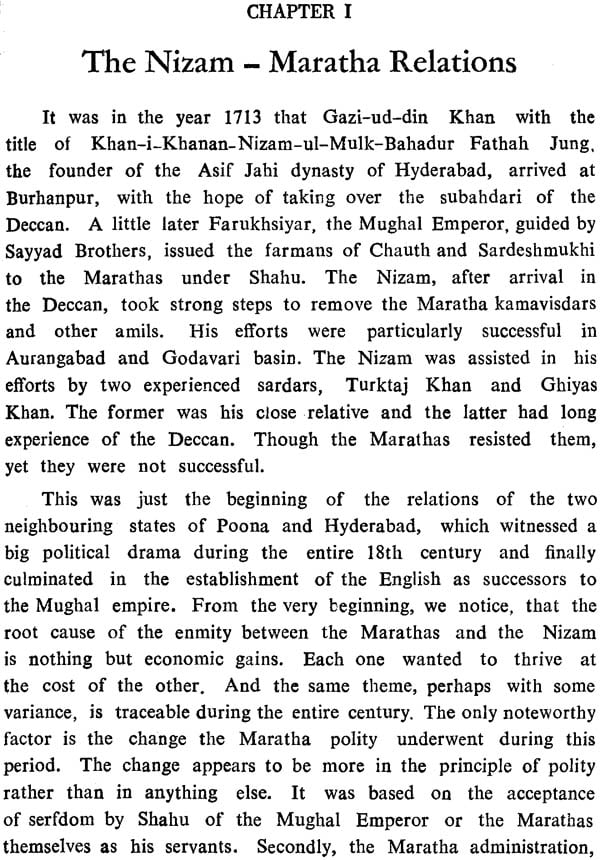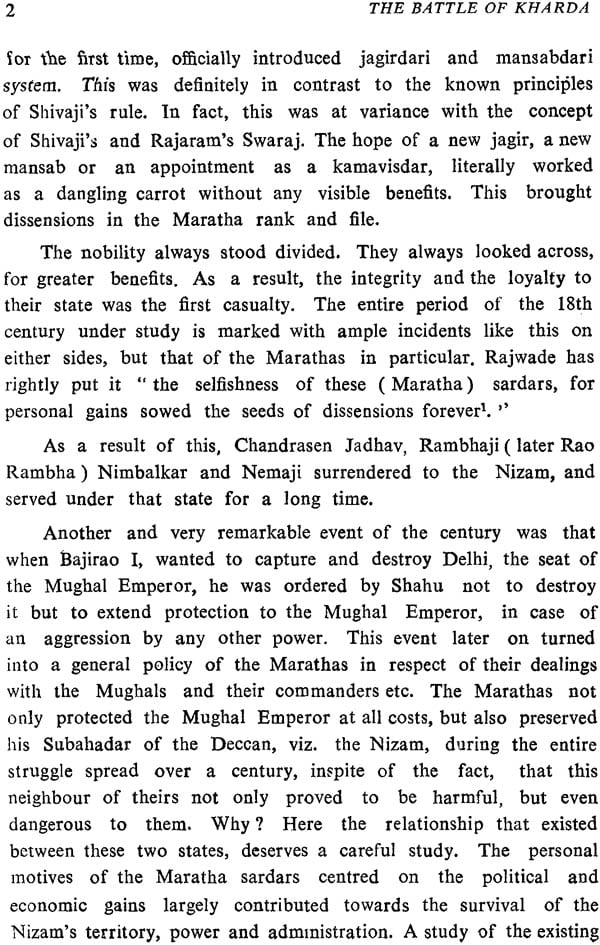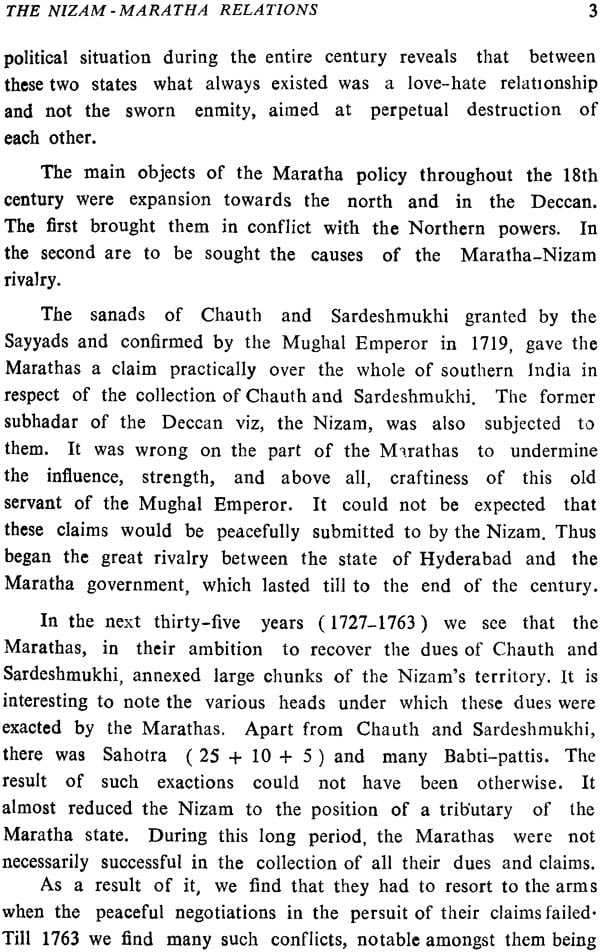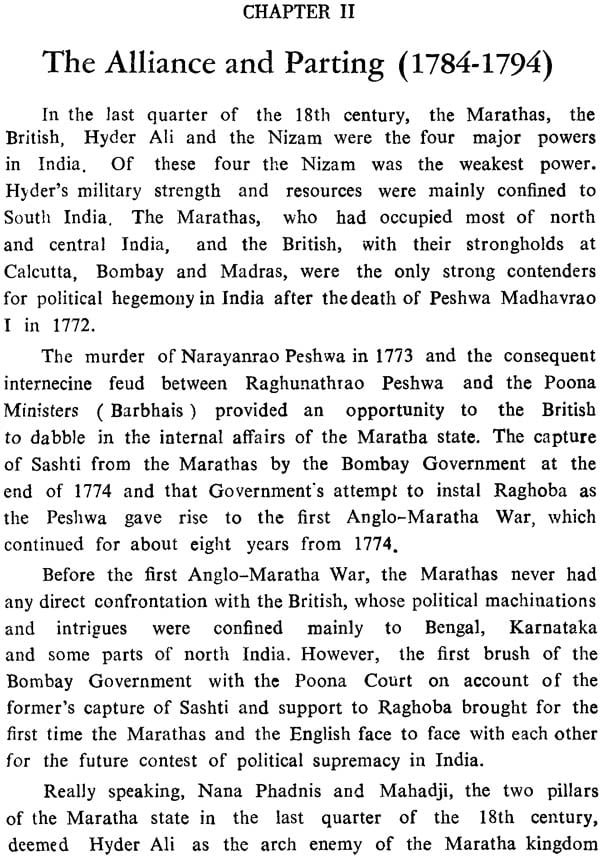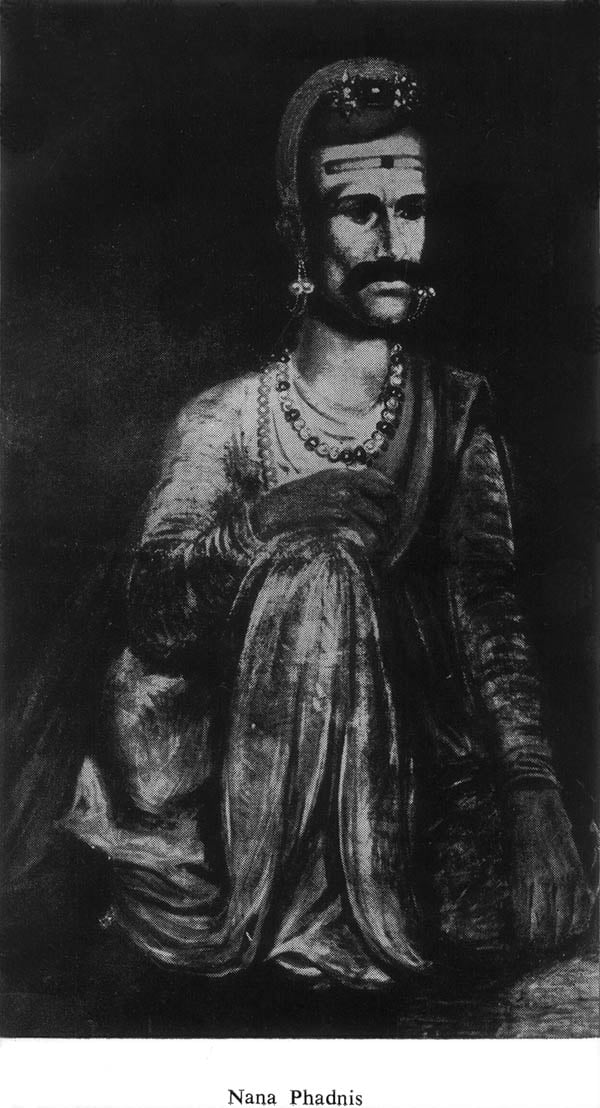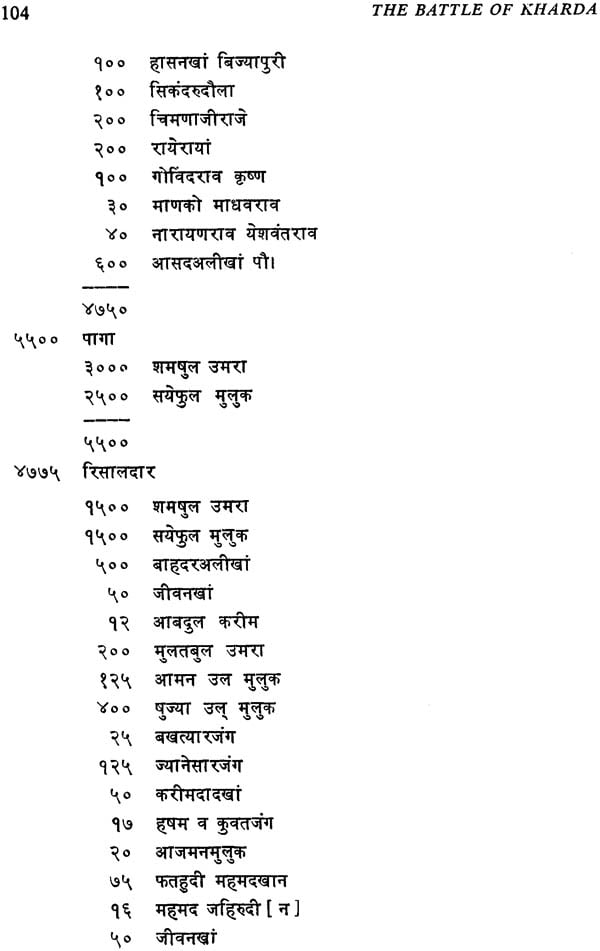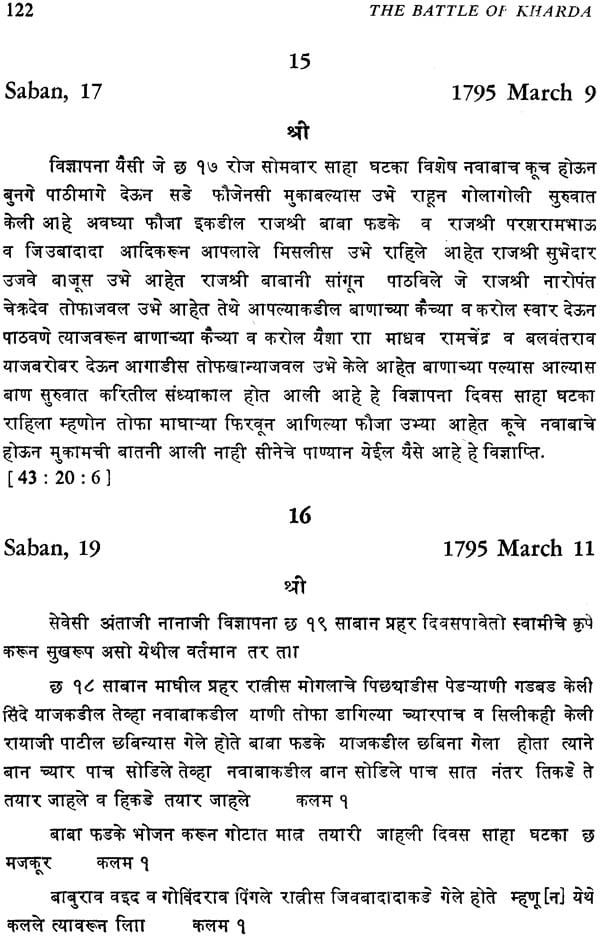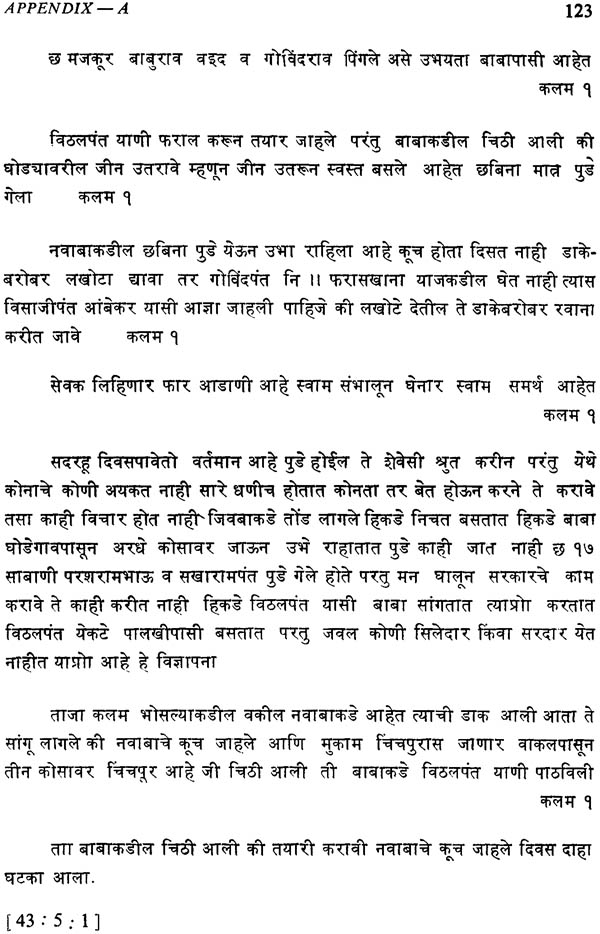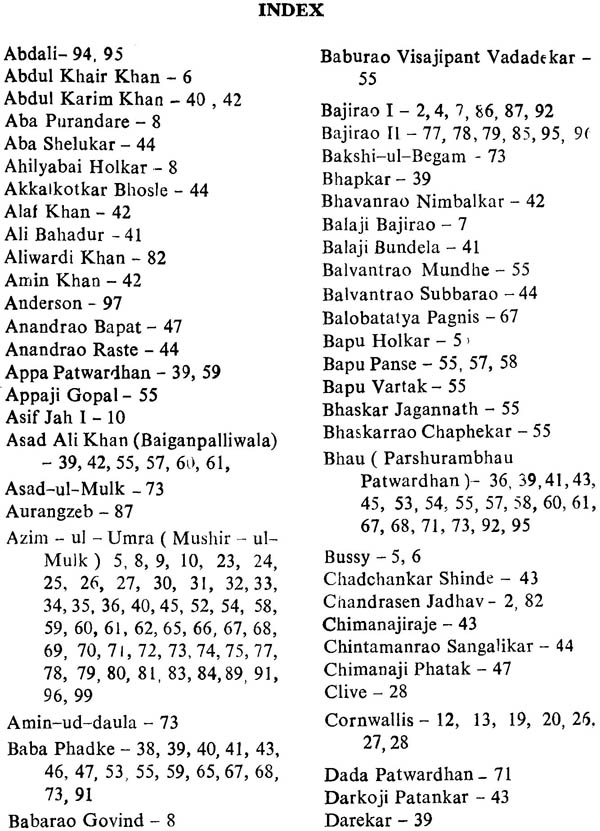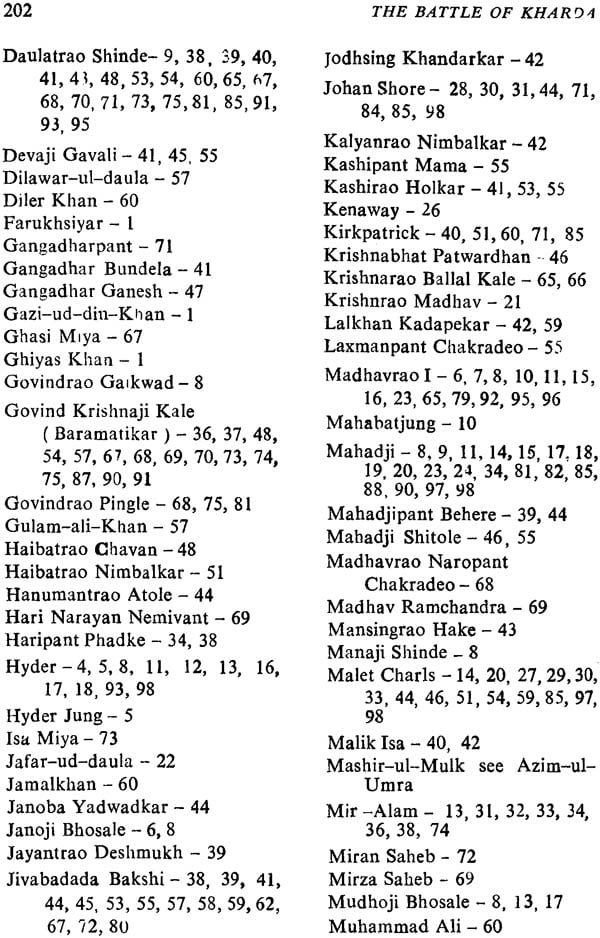
Battle of Kharda (Challenges and Responses)
Book Specification
| Item Code: | NAM207 |
| Author: | G.T. Kulkarni |
| Publisher: | Deccan College Postgraduate and Research Institute |
| Language: | Hindi and English |
| Edition: | 1980 |
| Pages: | 242 (8 B/W Illustration) |
| Cover: | Paperback |
| Other Details | 9.0 inch X 6.0 inch |
| Weight | 410 gm |
Book Description
Kharda, a small village in Bid district of the old Nizam State is a very obscure spot today and hardly attracts attention. Though Kharda is a remote spot, it has a remarkable historical background. Like Plassey, Kharda is a milestone in Indian history. It is full of paradoxes. Nizam AIi was severely defeated on the battlefield but managed to survive till the middle of the twentieth century. While the victors in the battle, the Marathas, became extinct within twenty years of this event. The observers of the battle, the British, profited most from it.
The battle of Kharda in 1795 was thus a momentous event in the history of India in general and the history of the Marathas in particular. After this battle, the political history of India took an altogether different turn and direction. Within seven years after this battle, the last Peshwa Bajirao Il was forced to enter into a Subsidiary Alliance with the British and subsequently had to relinquish the Maratha kingdom in 1818. It would not be an exaggeration, therefore, to say that the battle of Kharda was a crisis in which the old order of Indian political scene (led by the Marathas), yielded place to a new one, represented by the British.
Technically speaking, the battle of Kharda was an open clash between the Maratha State on the one side and Nizam Ali of Hyderabad on the other. The British were never in the picture. If, however, the battle is viewed in the right perspective, it will be found to be the confrontation between the most important Indian power and a foreign power, viz. the British East India Company, fighting by proxy, for political hegemony over India during the last quarter of the 18th century. As the Indian powers in general and the Marathas in particular failed to rise to the occasion, to the meet the British challenges, destiny willed the establishment of British rule in India.
This broad view has not been taken into consideration by the scholars and writers like Fraser, Vasudeoshastri Khare, G. S. Sardesai, Qasim Ali, * T. S. Shejwalkar, and Setu Madhavrao Pagadi, who have studied the battle so far. They have discussed the battle merely as a product of the mutual relations of friendship and antagonism between the Maratha State and the Asif Jahi dynasty. Most of these scholars have hailed and lauded the battle as the last great victory scored by the Marathas against their enemy. This is because these scholars have not utilised all the Marathi source-material relating to the battle of Kharda preserved in the Deccan College and Pune Archives.
Dr. V. G. Dighe, while editing the Poona Residency Correspondence (vol. IV) has attempted in his Introduction, to pen the work done by Malet and Kirkpatrick in the courts of the Marathas and the Nizam respectively. However, he has confined himself only to the task of editing the contemporary English documents and has not attempted the interpretation of the historical events with the help of these documents.
In the present work an attempt has been made to study all the possible source-material on the subject in Marathi, Persian and English with a view to presenting a fresh picture of this event. Dr. Dighe has rightly pointed out in his Introduction to the Maratha-Nizam relations that 'The event of the campaign of Kharda has so far been treated as a side issue which does not affect the main current of the history of the rise and growth of the British power in India.' Here the authors have now tried to marshall the evidence to establish that the campaign of Kharda was an event of utmost importance in the history of India which enabled the future ascendancy of the British power, the disintegration of the Maratha State and the surrender of the other smaller Indian rulers, including the Nizam, to the rule of the East India Company. While making an appreciation of this historical event, a special mention must be made of Prof. Shejwalkar's Marathi book entitled "Nizam-Peshwe Sambandha’. His work is an exhaustive study of the battle of Kharda made so far. The chief merit of his book lies in his use of almost all the published and unpublished Marathi and English contemporary records and his efforts to bring about the incompetence of the Maratha State without much eulogising their victory at Kharda. Still it must be humbly stated that the proper perspective required for interpreting the contemporary political events is absent in his writings. He has surveyed the Nizam Peshwa relations during the 18th century as a Hindu-Muslim struggle and has interpreted the failure of the Maratha State to smash completely the Nizam as a Muslim power and their own ultimate downfall, in the light of the mistakes of ommission and commission by the Marathas in general and the Peshwas in particular vis-a-vis the great Hindu ideals and traditions laid down by Shivaji, the founder of the Maratha Swaraj.
Prof Shejwalker's interpretation of the event is completely off the mark. Basically he has missed the point at issue which deserves attention and analysis viz the constant British presence in every important political event during the last quarter of the eighteenth century and their ascendnncy, This may be perhaps because of his not having done full justice to the English Records, even though, according to him, he has consulted them. Secondly, he has overlooked the fact that the political situation in the last quarter of the 18th century was far different from what it was during the 17th century and the first half of the 18th century. In the last quarter of the 18th century, the struggle for political supremacy in India had ceased to be merely a Hindu-Muslim affair. It had assumed the nature of a contest between the Indian powers, especially the Marathas on the one hand and foreign powers like the East India Company and the French etc.
Was the victory of the Marathas at Kharda a really resounding one as considered by Sardesai and others? If so, then the question arises - why is it that the Maratha State crumbled without much resistance within a short span of seven years (1802) after the battle? The present book attempts to give a satisfactory analysis of these events in the light of fresh historical evidence. The battle of Kharda and the subsequent events opened new avenues and new challenges to the Indian rulers in general and the Maratha leadership in particular, when they had to face the increasing predominance of the British in the political affairs of the Marathas. A systematic study of these events reveals the inability of the Maratha leadership to face these problems of increased dimensions satisfactorily.
In fact, the battle of Kharda was an outcome of the very poor responses given by the Maratha statesmen to the mighty challenges of the British power ever since the death of Peshwa Madhavrao I. The first British challenge came, when the Bombay Government captured the island of Sashti in 1774 and interfered with the internal affairs of the Marathas by attempting to instal Raghoba on Peshwa's gadi. Did the Maratha statemen give a fitting reply to this audacity of a foreign power which was expected to remain neutral? The answer is in the negative. Mahadji Shinde, one of the two pillars of the Maratha State during the last quarter of the 18th century, fell into the trap of Governor General Warren Hastings and concluded the treaty of Salbai in 1782. For self-interest, he relinquished the Maratha claim to Sashti island and sacrificed the friendship of Hyder, who was the only ruler to help the Marathas during the last stages of the first Anglo-Maratha war.
| Introduction | I to xiii | |
| I | The Nizam-Maratha Relations | 1 |
| II | The Alliance & Parting (1784-1794) | 14 |
| III | March to Kharda | 36 |
| IV | The Confrontation | 51 |
| V | Negotiations & Peace Treaty | 64 |
| VI | The Aftermath & Reappraisal | 77 |
| Appendix - A | 101 | |
| Appendix - B | 185 | |
| Bibliography | 195 |

